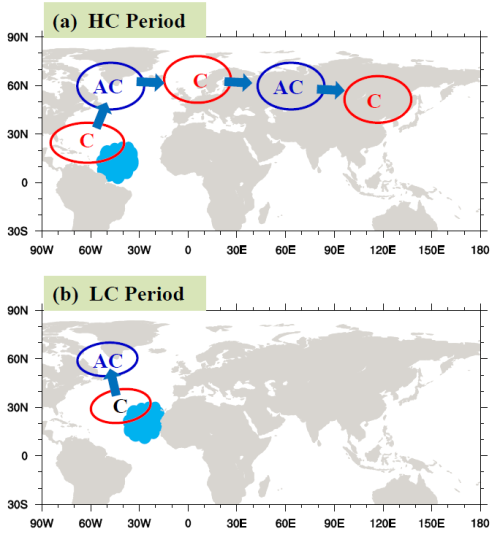State Key Laboratory of Numerical Modeling for Atmospheric Sciences and
Geophysical Fluid Dynamics (LASG)
Institute of Atmospheric Physics, Chinese Academy of Sciences

Vol. 3/No.3 August 2017
Scientists Reveal the Changing Impact of North Atlantic Ocean on the Eurasian Spring Surface Air Temperature
Surface air temperature (SAT) anomalies have pronounced impacts on agriculture, socioeconomic development, and people’s daily lives. For example, low summer SAT over Northeast China may lead to a significant reduction in local crop yield. The extremely high temperature over Europe in summer of 2003 resulted in extensive wildfires and substantial economic loss over many parts of Europe. Thus, it is important to investigate the factors for the Eurasian SAT variability and the sustainability of their influences.
Using observational data and barotropical model simulation, scientists from the Institute of Atmospheric Physics of the Chinese Academy of Sciences reported that the spring North Atlantic sea surface temperature (SST) anomalies have a pronounced influence on the SAT changes over the mid-high latitudes of Eurasian continent. "In an earlier study (Chen et al., 2016)”, says CHEN Shangfeng, one of the authors of the studies, "we found the North Atlantic SST anomalies trigger an atmospheric wave train extending from the North Atlantic to Eurasia, and induce the SAT changes over the Eurasian continent through wind-induced heat advection and cloud-induced surface radiation processes."

Schematic diagram: (a) Response of the atmospheric circulation to the anomalous atmospheric heating over the tropical North Atlantic during high correlation period.(b) Same as (a), but for low correlation period. Notation "C" represents anomalous cyclone, and "AC" represents anomalous anticyclone
In a recent study (Chen et al., 2017) published in Journal of Climate, they suggest that the connection between spring North Atlantic SST and the Eurasian SAT variations has experienced marked interdecadal changes in the past.
"These interdecadal changes are associated with changes in mean SST in the North Atlantic Ocean,"says WU Renguang, also the co-author of the studies, "Marked atmospheric heating anomalies appear over the tropical western North Atlantic when climatological mean SST is high in the tropical North Atlantic Ocean. These atmospheric heating anomalies are able to trigger an atmospheric wave train extending from the North Atlantic to Eurasia continent [Schematic diagram(a)]. Hence, influence of the North Atlantic SST anomalies on the Eurasian SAT variations is strong."
By contrast, when climatological mean SST is low in the tropical North Atlantic Ocean, anomalous atmospheric heating shifts northeastward to the subtropical central-eastern North Atlantic. Model experiments with a barotropical model confirms that anomalous atmospheric heating over the subtropical central-eastern North Atlantic cannot trigger an atmospheric wave train extending from the North Atlantic to Eurasia continent (Schematic diagram(b)). As such, influence of the North Atlantic SST anomalies on the Eurasian SAT is not obvious.
References:
Chen S., Wu R. (2017) Interdecadal changes in the relationship between interannual variations of spring North Atlantic SST and Eurasian surface air temperature. Journal of Climate, 30: 3771–3787. doi: 10.1175/JCLI-D-16-0477.1. http://journals.ametsoc.org/doi/abs/10.1175/JCLI-D-16-0477.1
Chen S., Wu R, Liu Y. (2016) Dominant modes of interannual variability in Eurasian surface air temperature during boreal spring. Journal of Climate, 29:1109-1125. doi:10.1175/JCLI-D-15-0524.1. http://dx.doi.org/10.1175/JCLI-D-15-0524.1
Contact: CHEN Shangfeng, chenshangfeng@mail.iap.ac.cn
E-mail: lasg_newsletter@lasg.iap.ac.cn
Editors: Chuanyi Wang (wangcy@lasg.iap.ac.cn), Kangjun Chen(ckj@lasg.iap.ac.cn)